The way to prepare for a more automated future is to know how to use technologies relevant to your work, said Peter Norvig, Research Director at Google.
Source: www.cnbc.com
The way to prepare for a more automated future is to know how to use technologies relevant to your work, said Peter Norvig, Research Director at Google.
Source: www.cnbc.com
Ford is testing an automated kiosk that allows customers to drop off and pick up their vehicles from the dealership at any time with the click of a button.
The Smart Service Kiosk, created with the help of Panasonic, launched at a Ford dealership in Michigan this January. After a test run of 90 days, Ford will consider expanding the service.
Click here for full article with pics
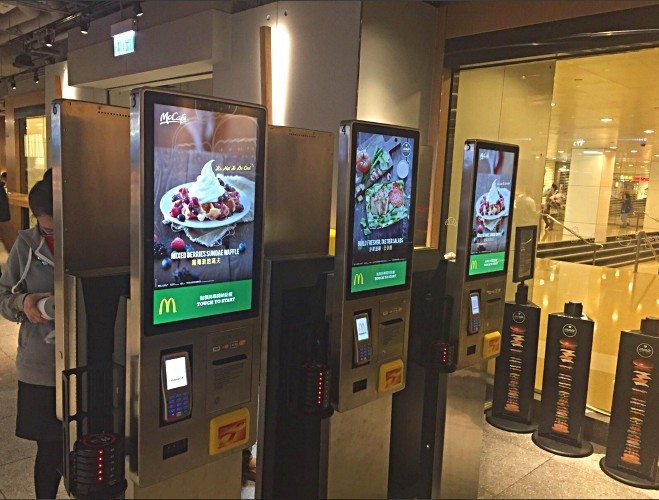
Excerpts and photos
Upon entering one is directed to ordering kiosks or to registers. While one may order regular items from the kiosks the benefit is to secure the waiter service and a lit numbered disc, (used at other quick served restaurants). The benefit is to serve not just the burger fans, but health conscious and vegetarians as well. One can order the specialty made salads that feature couscous and quinoa along with asparagus and chicken breasts. An open kitchen is presented to all patrons to observe.
A short time after we seated ourselves for dinner the waiter arrived to retrieve the disc and to present our food and inquire if there was anything else he could provide. In terms of the quality, both the custom made Angus burger and the salad were above the usual McDonald’s quality as the choices of cheeses, bread, and toppings were unique. All salads were removed from McDonald’s in Hong Kong a few years ago as a result of a supply quality issue. As such, this was our guest’s first salad of any type at McDonald’s in years. It was quite fresh and nutritious with a choose of salad dressings. The fries were the same quality as usual, with no issues. The presentation in a wire basket added to the presentation and music was piped in for ambiance. Charging stations for tablets and phones, etc. at each booth were provided, but on both visits were not working. Sixty minutes free WIFI service is provided which is now prevalent in almost all Hong Kong McDonald’s at this time.
Overall, it was a good experience and worth the repeated visits. Our lunchtime companion believed it was overpriced but the environment at lunch may have had something to do with his outlook. We expect to return to try the other items from the menu but would most likely visit either during an evening or later in the afternoon after the lunchtime crush.
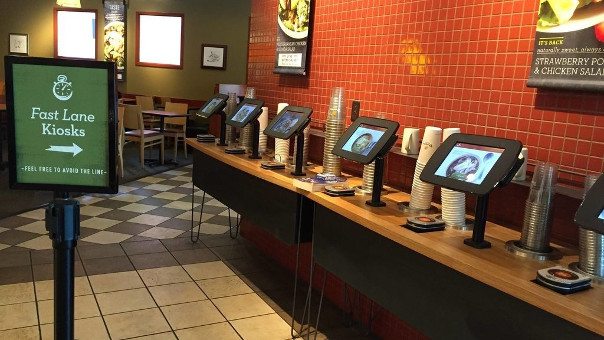
This may be a smartphone age, but our lives are becoming a series of kiosk stops, from ATMs and supermarket checkouts to airlines and gas stations. And now, there’s the fast-food kiosk. Kiosks have one main purpose: to save time.
Source: www.qsrmagazine.com
Panera claims 60 percent of lunchtime transactions are completed on touch-screen kiosks at one bustling, Boston-area store near Fenway Park. That same 60 percent is what some of the savviest fast-food restaurants do daily out of their drive-thru windows.
“Kiosks turn a restaurant into a vending machine,” says Christopher Muller, professor of hospitality at Boston University.
Panera installed kiosks at that one location near Fenway Park back in 2012. Today, it has them in roughly 400 restaurants as part of its “Panera 2.0” platform, with plans to have them in virtually all of its 2,000 or so stores within a few years, says Blaine Hurst, executive vice president and chief transformation and growth officer at Panera.
“We’re seeing phenomenal results,” Hurst says. That’s because kiosk-using customers are generally happy customers, he says. They typically get their orders faster and, by a healthy margin, they come back to the restaurant more often, he says. That might explain Panera’s savvy name for its contraptions: Fast Lane Kiosks.
Highlights
Editors Note: If you are wondering who designed, engineered and manufactured the tablets used by Paneras, we can say for sure that they look to be from our member Lilitab. Please visit their page and say hello.
Read full article on QSR Magazine.
[contact-form to=’[email protected]’ subject=’Panera Contact Form’][contact-field label=’Name’ type=’name’ required=’1’/][contact-field label=’Email’ type=’email’ required=’1’/][contact-field label=’Telephone’ type=’text’/][contact-field label=’Comment’ type=’textarea’ required=’1’/][/contact-form]
Mobile Kiosk or NFC Kiosk for Mobiles
F&I documents, vehicle sales agreements, brochures and more, we all know that dealerships are businesses that rely heavily on printed products.
Source: www.autoremarketing.com
The company has made NFTouch available in a variety of dealer packages. FRG shared the base package for the product includes four “wheel” kiosks (digital stands next to a showroom vehicle) and a showroom Master kiosk (which provides discount coupons, showcases campaigns, monthly features and specials). The Digital Wheel Stand allows the sales manager to instantly change vehicle pricing and offers.
The packages are customized in an effort to suit dealer needs, and the kiosks are leased over a set term, with delivery and installation within 60 days of ordering.
And for shoppers that might not have made it to the dealership within store hours; they can receive information, as well. The company also offers an After-Hours kiosk, which sits just inside the dealership window and works through glass.
Airport Kiosk
Malaysia Airlines has closed its economy check-in counters at Kuala Lumpur as the airline moves to
Source: www.ausbt.com.au
First time I have seen “mandatory” for Economy class. First Class & Business still get to talk to people for check-in
Deputies have a new kiosk to thank for helping them find a suspect in Marion County.
Source: www.mynews13.com
A guide to choosing green computing for your IT department. Learn how and why you should consider improving energy efficiency techniques within your business.
Source: www.computerweekly.com
Green computing is no longer just a white-wash expression, as government standards like the Carbon Reduction Commitment (CRC), the Climate Change Agreement (CCA) or the European Union Emission Trading (EU ETS), encourage companies to revaluate their use of IT resources.
New York City residents and visitors can access the Internet and make phone calls for free at the sidewalk kiosks.
Source: www.pcmag.com
Source: lilitab-sujc.soundestlink.com
Newsletter from Lilitab on iPad Mini Tablet Kiosk System. You can contact Michael McCloud at Lilitab via email at [email protected]
As the only tablet kiosk company that is an Apple “Made for iOS” manufacturer, we are uniquely qualified to build custom kiosk 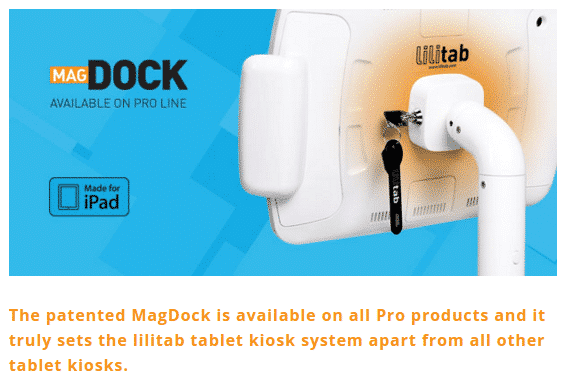
Kiosk Design Tips : Blog article on designing kiosk application to scale. Creating a kiosk application capable of scaling from a handful of kiosks at a single location, up to thousands of kiosks spread across multiple regions requires that you design for scalability from day one.
Source: blog.kiosksimple.com
1. Offload computation to the kiosk to reduce the workload on the server
2. Choose the right database engine based on the nature of your data
3. Use a reliable content delivery network with geo-location to rapidly deliver content


Dartmouth told IPVM they picked the K3 because they were contact-free, available in the quantity they required, quick to ship, and accurate. They are using the devices as personal temperature stations for daily check-ins as opposed to fever screening for entry to buildings, in line with CDC guidelines. The daily check-ins are also only part of their coronavirus safety plan that involves testing, social distancing, masks, travel restrictions, infrastructure changes, contact tracing, and quarantining.
Cost per device is less than $100. We can see them on Amazon for $79 and less.
IPVM Finds K3s Fairly Accurate and Cost-Effective
IPVM has found K3s to be fairly accurate and easy to use despite being one of the cheapest options at ~$100. In our tests of K3s, they performed comparably to handheld IR guns in temperature-controlled areas and were more accurate than most of the alternatives we tested. K3s work well in a temperature-controlled environment but suffer from poor accuracy in heated or humid rooms. In addition, false-positives can be triggered by people measuring their temperature after sweating or being outside in the sun because they measure the forehead. K3s are easy to use and convenient because they are contact-free and can be used without a second person.
K3s Used for Self Screening as Public Thermometers
Dartmouth is using the K3s as thermometer stations for people without personal thermometers so they can complete daily Coronavirus symptom checks. Dartmouth requires students and staff to complete daily electronic coronavirus symptom checks that include temperature. If people don’t have access to thermometers, they are told to use one of the K3s distributed across campus. Dartmouth told IPVM the 32 K3s were placed in areas that had high foot traffic or density:
Placement was based on foot traffic patterns and population density of the buildings/areas.
This is notably different from many places that use temperature screening for entry to buildings and Dartmouth’s strategy matches CDC guidelines:
Screening and health checks are not a replacement for other protective measures such as social distancing.
Consider encouraging individuals planning to enter the workplace to self-screen prior to coming onsite
From Test Report of K3
Summary
In our testing, the wall-mounted IR temperature gun was relatively accurate in climate-controlled conditions, such as lobbies and offices, with measurements consistently ~0.2-0.5° lower than body temperature measured using tympanic and oral thermometers.
However, in areas with higher temperatures and relative humidity, temperature measurements were significantly lower than actual body temperature, as much as 1.5°F. Additionally, there is no way to compensate for these low measurements, as the unit does not include adjustable body temperature offsets or alarm thresholds typical on most handheld thermometers and thermal camera screening systems.
Finally, mounting height significantly impacts usability due to the thermometers small spot size and short range (5-10cm / ~2-4″), with tall users needing to bend for measurement, while shorter users may require a box/step to stand on. However, for the price, users could simply install a second detector for varying heights.
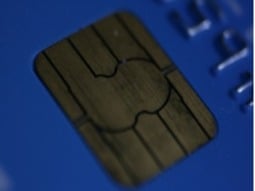 EMV Liability Shift
EMV Liability ShiftDespite the October 1st liability shift deadline looming, only 10 per cent of Americans have received the new chip-enabled cards, and nearly a third don’t know how to use them.
Source: www.paymenteye.com
The survey, conducted by the GfK Public Affairs for Associated Press, found that out of 1004 Americans polled, only one in every ten have received the new cards.
Furthermore, out of those people who have received the cards just one-third (35 per cent) say they actually use them as intended on the new card readers.
Moreover, of the people who have received the chip cards, 70 per cent said they know how to use it, meaning nearly a third of people do not understand.
The end of the swipe-and-sign era is right around the corner, and merchants such as bars and restaurants could face major risk as of October if they haven’t migrated their point of sale systems to accept EMV.
Source: www.paymentssource.com

EMV Kiosk – Getting Past the Finish Line
If you concern yourself with the kiosk industry enough to read this 
It is not just the hardware:
EMV hardware manufacturers and distributors have spent the last few years focused on educating ISV/ISOs and hardware integrators that EMV is not just a matter of buying a new piece of hardware. A true solution is dependent on a marriage of hardware and software; and as marriages go it also entails a commitment. More on that to come…
EMV Levels:
EMV Level 1 means that a device physically meets EMV specifications for chip (contact), and in some cases NFC (contactless).
EMV Level 2 means that the firmware on a device performs to EMV processing specifications.
Both EMV Level 1 and Level 2 are the responsibility of terminal manufacturers. This hardware can be described as “EMV ready.”
Level 3 is achieved when a developer marries a device meeting the aforementioned Level 1 and 2 EMV specifications with their software, and commits to certifying it with a processor or processors, and then the card brands. This fully developed and certified solution can be described as “EMV capable.”
The cost and level of commitment:
The cost of this commitment can definitely set you back more than a designer engagement ring, depending on the ring of course. The cost and level of commitment varies greatly depending on the developer’s goals.
A developer can choose to pursue a direct certification with a processor (fully integrated) or decide to use a payment gateway which has already made a commitment to certifying a piece of hardware with a processor(s) (semi-integrated).
Fully integrated vs. semi-integrated:
A fully integrated approach to EMV is a time consuming a very costly endeavor and the end solution is fully within PCI scope. 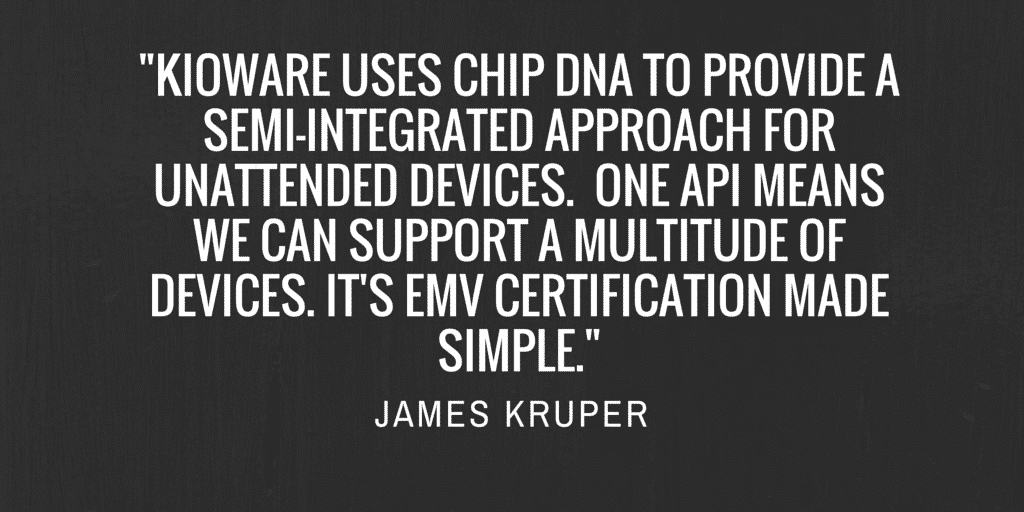
A semi-integrated approach allows you to leverage the commitment of another company to complete your solution in a matter of weeks, and at an enormously reduced cost. In addition to the cost factor a semi-integrated solution also allows you to piggyback on your gateway partner’s PCI-DSS compliance. A semi-integrated approach eliminates your need for full-blown PCI and EMV evaluation. In most cases semi-integrated system architecture will allow for a PCI Self Assessment Questionnaire (SAQ) to obtain your attestation of compliance.
Conclusion:
I hope after reading this you have a better understanding of why just picking a piece of hardware that meets EMV Levels 1 and 2 doesn’t make a EMV capable solution. The Liability Shift is coming in October and we are here to help you prepare. For more answers to your questions, and for information on middleware available to you, please contact Unattended Card Payments Inc. at (702) 802-3504 or by emailing [email protected]
Ingenico Webinar on EMV – Myths Debunked
Tomorrow September 23 at 2 PM Eastern Time.
Let’s face it. When it comes to the U.S. EMV liability shift, there is conflicting information about what it is, who it impacts, and even when it actually starts. We’d like to finally put an end to the confusion and equip you with the facts.
In this webinar. our payment experts will address common misconceptions and provide answers to frequently asked questions, such as:
Featured speakers:
Greg Burch, VP of Mobility and Business Development, Ingenico Group / North America
Allen Friedman, VP of Payments Solutions, Ingenico Group / North America
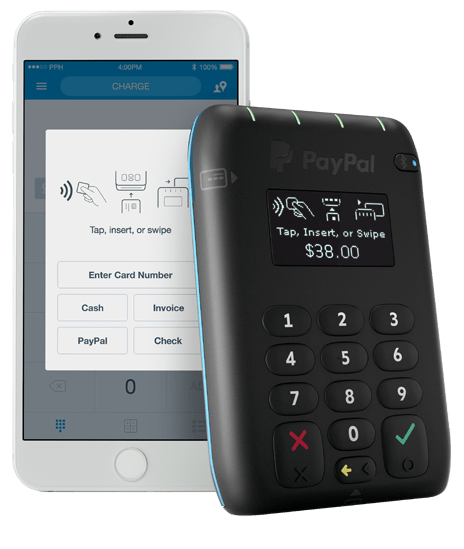
With the arrival of Apple Pay and, more recently, Android Pay, consumers are becoming more comfortable with alternative ways of paying that don’t involve credit card swipes. And now, with the U.S.’s transition to EMV – smart cards that store data on chips instead of magnetic stripes, which offers increased security – many business owners will have to upgrade their hardware in order to support these newer chip-and-PIN cards.
Today, PayPal unveiled its strategy to compete amid all the changes taking place in the payments landscape with the unveiling of its PayPal Here Chip Card Reader in the U.S. The reader now supports not only EMV, but also magnetic stripe cards and NFC, including Apple Pay, Android Pay, Samsung Pay, and more.
As PayPal VP and GM Brad Brodigan explains, consumers today expect to “pay anywhere, anytime and any way they please,” which is why the company needed to enter the game with a multi-functional card reader. At the same time, businesses themselves are preparing for the EMV liability shift taking place on October 1, 2015. At that time, merchants who won’t accept chip cards will become liable for point-of-sale fraud when customers use their chip cards – a strong incentive to encourage business owners to upgrade their hardware. That’s where the PayPal Here reader comes in.
Unattended Card Payments Inc. Begins Shipping the iUC285 in the U.S. As main Ingenico VAR for unattended hardware, UCP Inc. announces they have received first shipment of iUC285 beta units.
Source: www.ucp-inc.com
These units are designed for unattended and are being certified with multiple processors as we speak.
Here is spec sheet.
Nice write up on kiosks versus tablets in the QSR ordering space.
Source: globenewswire.com
When it comes to mobile apps vs. kiosks in the restaurant field, here’s why some experts give the edge to using a self-service ordering device over a mobile app:
Excerpt:
What has made kiosks particularly enticing to consumers is their efficiency.
Customers want to buy products that are easily available, within their budget and present the required information pertaining to ingredients, product details, nutritional value and others. Products and information provided at kiosks quickly cater to those demands.
“When kiosks first came along, there was a learning curve for users,” Vasa said. “It took them some time to figure them out. As time has gone on, kiosks are everywhere. Exposure has helped people understand the technology and become more comfortable with it. Kiosks no longer are seen as potential obstacles, but rather as necessities.”
Juke Slot develops automated technology designed to facilitate faster service and provide entertainment for consumers in the casino, hospitality and restaurant industries. Its Android-based kiosks’ sole purpose is to provide faster service and entertainment to the everyday public environment, with customized application capabilities based on customer needs.
The company’s device provides a tableside ordering, custom designed EMV-certified hardware solution that enables secure transactions. Juke Slot’s lineup also features a standup touchscreen kiosk aimed at the quick service industry.
Juke Slot focuses on giving its customers more control of their operation — over their customer ordering process, over their onsite marketing and over their business processes.
For more information or to purchase Juke Slot’s software or kiosks, email [email protected].
With less than a month to go before the VISA ATM liability shift deadline, you might expect a frantic, last-ditch effort by ATM operators to get their machines EMV-ready. But you would be wrong.
Source: www.atmmarketplace.com
Nice article by CEO of Triton
Reprinted with permission.. Protect Yourself From Fraud and Identify Theft In 2018 Fraud protection. Unfortunately, we live in a time when identity theft and fraud are running rampant. Almost every month we hear of major security breaches, with companies like Yahoo, Uber, Equifax, and Dropbox all compromised. When these types of breaches occur, millions of usernames and passwords are hacked, often resulting in identity theft and fraud. So what can you do to protect yourself in 2018? What steps can you take to ensure that you don’t get hacked? We’re going to break down the how, what, and why of protecting yourself, touching on everything from your digital accounts to … Continue reading Protect Yourself From Fraud and Identity Theft In 2018 →
Source: digitalbusiness.us
Very nice and complete article on Identify Theft and Fraud Protection. Includes specific tips for self-service technology engagements (gas pumps, ATMs, self-checkout, etc).
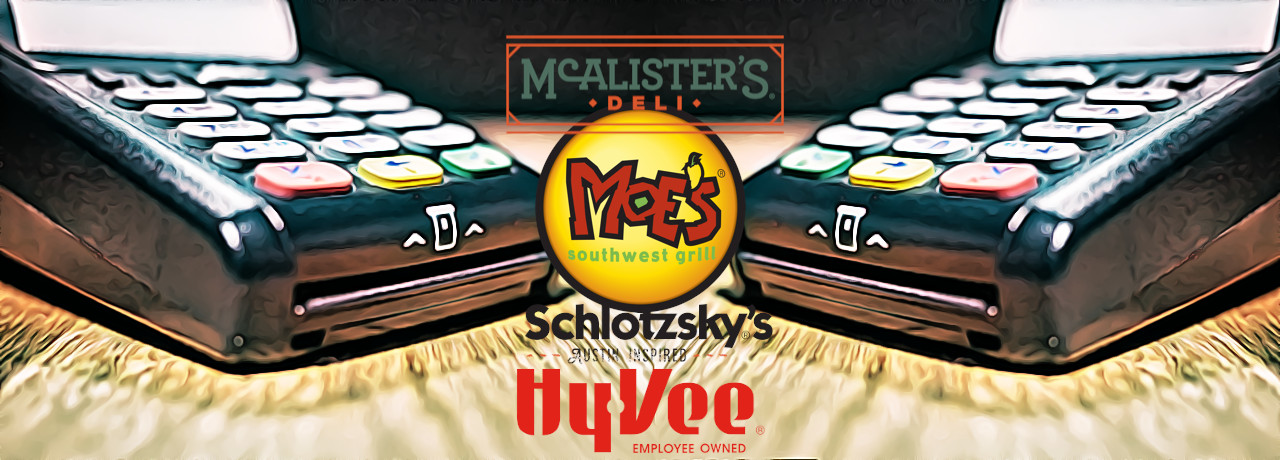
Hackers caused havoc at four restaurant chains in the U.S. over the summer after compromising their payment systems with malware that stole customers’ payment card information.
In the last two days, McAlister’s Deli, Moe’s Southwest Grill, Schlotzsky’s, and Hy-Vee disclosed publicly that their networks were infected with point-of-sale malware copying data from cards used in person at certain locations.
McAlister’s, Moe’s, and Schlotzsky’s together have around 1,500 locations spread across the U.S. and are owned by the same parent company, Focus Brands.
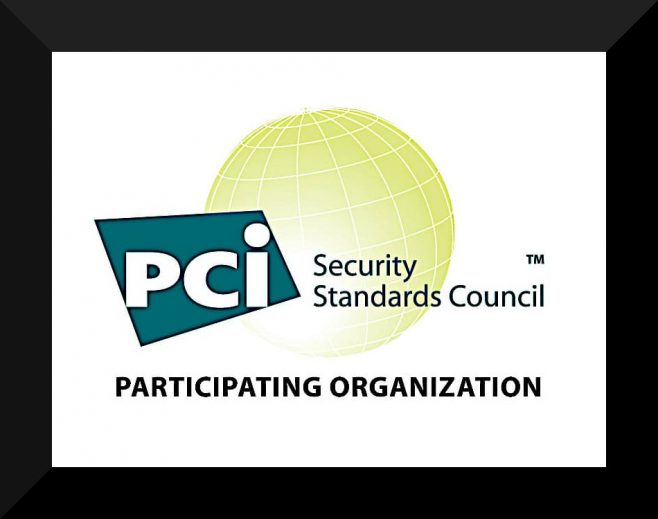
BusinessWire — Westminster, CO, April 28, 2020 — The Kiosk Manufacturer Association (KMA), an organization focused on self-service, announced today that it has joined the PCI Security Standards Council (PCI SSC) as a new Participating Organization. KMA will work with the PCI SSC to help secure payment data worldwide through the ongoing development and adoption of the PCI Security Standards.
The PCI SSC leads a global, cross-industry effort to increase payment security by providing flexible, industry-driven and effective data security standards and programs. The keystone is the PCI Data Security Standard (PCI DSS), which provides an actionable framework for developing a robust payment card data security process and preventing, detecting and mitigating criminal attacks and breaches.
As a Participating Organization, the KMA adds its voice to the standards development process and will collaborate with a growing community of more than 800 Participating Organizations to improve payment security worldwide. KMA will also have the opportunity to recommend new initiatives for consideration to the PCI Security Standards Council and share cross-sector experiences and best practices at the annual PCI Community Meetings.
“In an era of increasingly sophisticated attacks on systems, PCI Security Standards and resources help organizations secure payment data and prevent, detect and mitigate attacks that can lead to costly data breaches,” said Mauro Lance, Chief Operating Officer of the PCI Security Standards Council. “By joining as a Participating Organization, KMA demonstrates they are playing an active part in improving payment security globally by helping drive awareness and adoption of PCI Security Standards.”
“Unattended self-service kiosk manufacturers deal with PCI every day. We communicate simplicity but also liabilities,” said Craig Keefner, with KMA. “We’ll propose Special Interest Group (SIG) for unattended. Our PCI-EMV steering committee is Unattended Card Payments Inc., DCAP Systems, Ingenico, Self-Service Networks and KioWare. We hope to duplicate our ADA Accessibility initiatives’ success.”
About the PCI Security Standards Council
The PCI Security Standards Council is a global forum responsible for the development, management, education, and awareness of the PCI Data Security Standard (PCI DSS) and other standards that increase payment data security. Connect with the PCI Council on LinkedIn. Join on Twitter @PCISSC. Subscribe – PCI Perspectives Blog.
KMA is a global organization for unattended self-service kiosks. Marketing: https://kioskindustry.org. Gold sponsors: Olea, KioWare, Nanonation, Pyramid, Frank Mayer, Vispero, Zebra, Honeywell
# # #
Media contacts
PCI Security Standards Council
Name Lindsay Goodspeed
Tel 781-258-5843
Email [email protected]
KMA
Craig Keefner 720-324-1837 [email protected]
Other Useful Links
From Smart City Design Feb 2021
Feb 5, 2021 — Statement from Storm Interface following conference call with NFB on the use of personal phones as an accessible interface to Smart City terminals.
Use of personal phones as an accessible interface
As a manufacturer of Accessible System Interface Devices, including Touchless Kiosk Interface Devices (TKI), Storm Interface are concerned that, following the NFB online conference (IKE Smart City Presentation), clarification is needed about the suitability of mobile phones as a primary (or sole) accessible interface to self-service and ICT systems.
Our concern centers around the needs of people with a diverse range of sensory, physical, dexterity, and cognitive impairments. Including, but certainly not limited to, those with sight impairments.
Use of a touchscreen smartphone as a primary system interface discriminates against the following groups: –
When proposing Storm’s Touchless Kiosk Interface (TKI) as an aid to accessibility it is our policy to promote TKI as part of a multi-technology accessible interface solution. It should only be promoted as an augmentation and supplement to tactilely discernible navigation and control of both audible content and visible content displayed on a screen. It cannot and should not be promoted or considered as a compliant accessible interface when used in isolation.
For more information visit Storm Interface
Accelerating Value and Impact to Strengthen Competitive Position — Send2Press press release
 LOS ANGELES, Calif., Feb. 2, 2021 (NEWSWIRE) — Olea Kiosks®, Inc., a visionary provider of innovative self-service kiosk solutions, today announced the growth of its leadership team to include sales management and strategic business development. The company has expanded the role of Rusty Gaynes to Director of Sales, Alliances and Strategic Partnerships and promoted Daniel Olea to Director of Strategy and Business Development.
LOS ANGELES, Calif., Feb. 2, 2021 (NEWSWIRE) — Olea Kiosks®, Inc., a visionary provider of innovative self-service kiosk solutions, today announced the growth of its leadership team to include sales management and strategic business development. The company has expanded the role of Rusty Gaynes to Director of Sales, Alliances and Strategic Partnerships and promoted Daniel Olea to Director of Strategy and Business Development.
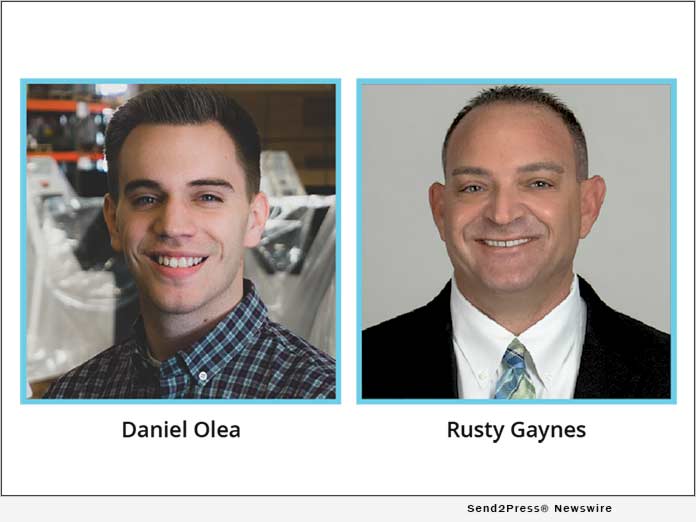
PHOTO CAPTION: (L-R) Daniel Olea and Rusty Gaynes.
Rusty started with Olea in July of 2020 creating the alliances and strategic partnerships program and he will continue to oversee all aspects of the partnership ecosystem including the creation of innovative partner offerings and go-to-market strategies. Expansion of his duties includes leading the sales team to deliver against revenue goals. Rusty will also be instrumental in helping to identify and remove obstacles that impact sales productivity as the company further develops its inside sales and operational processes.
As the fourth generation in the business, Daniel has spent almost four years as an account executive with the company, and each year demonstrated growth. With a strong understanding of strategic initiatives, he will lead the company in its development of long-term growth plans. With his detailed analysis and recognition of emerging trends, in this role, Daniel will drive business development activities as well as continue to enhance corporate strategy.
“With the announcement of our recent manufacturing expansion, it was also time to align the rest of the organization to ensure we have the focus necessary for the future,” said Olea Kiosks Inc. CEO Frank Olea. “As I transition some of my duties to both Rusty and Daniel, this will serve as a great accelerator for our team in helping us grow our value and impact as we strengthen our competitive position in the marketplace,” explained Frank Olea, CEO.
About Olea Kiosks®, Inc.
Olea Kiosks Inc., is a self-service kiosk solution provider for the attractions and entertainment, healthcare and hospitality industries. Its technologically advanced, in-house manufacturing, design, and innovation have made it an industry leader. Headquartered in Los Angeles, California, customers include The Habit Burger Grill, Kaiser Permanente, Empire State Building, Universal Studios, EVO Entertainment, Scientific Games, and Subway.
For more information, visit https://www.olea.com/.
*PHOTO link for media: https://www.Send2Press.com/300dpi/21-0202s2p-Olea-Leadership-Growth-Daniel-Rusty-300dpi.jpg
News Source: Olea Kiosks
Frank Olea — For the first time in the 45+ year history of Olea Kiosks we have put someone other than an Olea in charge of the sales team. Rusty Gaynes is going to be a huge help in our growth strategy by allowing me more time to work on the future of Kiosks and Self-Service. And Daniel Olea has really proven himself to be a very strategic thinker pulling us in new directions much like I did when I took us out of the Exhibit business and into Kiosks almost 30 years ago. Press release on these two below.
New team members, expanded factory space, what’s next???

Article on Wired Nov2020
Wired did an investigation into kiosks (well, temperature tablets…) and has determined schools are purchasing thermal cameras that include facial recognition technology.
Ok. We can live with that…
Technically most all of the schools have been purchasing infrared sensor-based tablets. They are not thermal cameras (e.g. FLIR A400). We think it is safe to say looking at the RFPs and RFIs that the number is easily over 200 schools. Off the top of our heads figure 500 units for a large school district and at figure 40 school districts. We could include Colleges and Universities as well. Maybe we should include FEMA and DHS while we are at it. Reminds me of that old Sinatra tune.
But Munir says he knows little about the “top-of-the-line” facial recognition algorithms at the core of his expansion plans. “That’s almost like a black box for the OneScreen team,” he says. “We rely on the technology we are given.” He directed WIRED to Qualcomm, which makes the device’s processor, to answer additional questions about the facial recognition features and how they were tested for accuracy. Sanjeet Pandit, a Qualcomm vice president, confirms that OneScreen is the only thermal camera provider licensed to use its chips, but says Qualcomm does not provide the facial recognition technology used in the tablets. Munir did not directly answer a follow-up question about who had developed the facial recognition algorithms used in the device.
It’s a worthwhile read and within it there are references to IPVM who has done most of the heavy lifting in this area.
Some of the major distributors have been HP and CDW. The systems have been characterized “hygiene theater” by the CEO of Marriott and also a public hazard by independent testing groups such as IPVM. Given the false negatives they represent a public health situation.
It is good to see major publications beginning to see the developing story that we in the self-service market have been living with for the last 9 months.
We do think it is worth examining these technologies in the corporate employee space as well. That would cover both sides of the coin. Recently we saw where 6,000 units deployed at Home Depot. What is the basis and manufacture of those tablets?
What about Six Flags? They went with Dahua who is blacklisted Chinese firm.
Are there any tablets manufactured and designed in the U.S.? I remember some trying on the purpose-built basis but ultimately failing (China was cheaper).
Some of the technologies which have jumped on the temperature tablet for a free ride include AI, facial, and on the hardware-side cameras.
Facial recognition requirements have grown and are a booming business. Video cameras are next up in the queue.

Report of recent requirements for facial recognition. Figure $400M for the immediate market and average 300K per deal — KioskIndustry
https://ipvm.com/reports/meridian-china-medical
Updated Fever Tablet Temperature Screening Relabelers & Sensors
Chicago, March 9, 2017 – Cooling Units Ideal for Kiosk and OEM
Kiosk components require specific temperature ranges for reliable, optimal performance. Although any TECA air conditioner can be installed in a kiosk, TECA now offers a complete line of thermoelectric air conditioners designed specifically for kiosk and OEM applications. The product line spans from 155-1,270 BTU/hr and is suitable for indoor or outdoor kiosks. Each cooler has a unique internal-mount design. There is no extrusion into the ambient environment.
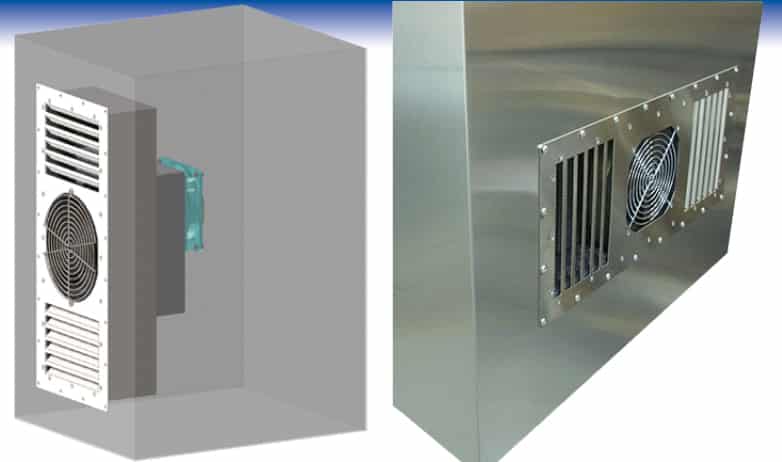
Customization is available. Thermoelectric cooling is a reliable and maintenance free way to protect electronics and equipment.
Visit TECA today to learn more
http://www.thermoelectric.com/product-matrix/internal- mount-air- conditioners/
Hospitality partnership news excerpt from press release —
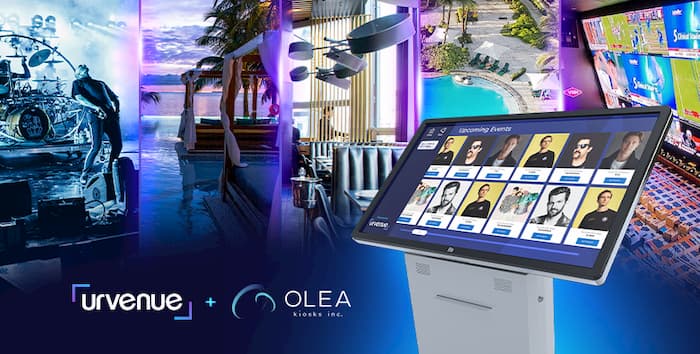
Hospitality self-service kiosk solution by Olea Kiosks, Inc.
An Olea kiosk paired with UrVenue’s booking solution puts hospitality patrons in the driver’s seat with frictionless, on-property, cashier-less, self-service booking capabilities. Guests can now book and transact any inventory within UrVenue, including but not limited to, special event ticketing such as seasonal pop-up experiences, show tickets, restaurant reservations, pool-side cabanas, nightclub and day club admission, special promotion vouchers, sportsbook lounge seats and bundled on-property experiences to name a few. UrVenue’s hospitality-built booking platform makes it is easy to transact any type of non-room inventory on property and with Olea’s flexible, modular design, the physical unit can be branded and designed for custom transactions including physical outputs such as show tickets or customized promotional vouchers or wristbands.
Self-Service Hospitality Solutions Designed to Reduce Friction in the Guest Experience
Dec 09, 2020, 10:13 ET
LOS ANGELES, Dec. 9, 2020 /PRNewswire/ — Olea Kiosks®, Inc., a visionary provider of self-service kiosk solutions, today announced a strategic partnership with UrVenue, the leading hospitality technology platform that powers commerce, enhances the guest experience and monetizes a resort’s real estate. With conveniently placed Olea kiosks on-property, this partnership enables venues and hotel properties to layer in another customer touchpoint that drives self-service revenue with transactions that are contactless, resource-free, branded, and always open for business.
With more than 40 years of delivering self-service solutions, Olea Kiosks® understands the value of reducing friction in the guest experience. Urvenue’s 10+ years of experience in the resorts and hospitality realm and its ability to leverage its technology to monetize non-room inventory and other guest touchpoints during the in-stay journey solves one of the greatest challenges for resort managers. Combining UrVenue’s powerful booking platform with self-service kiosks puts guests in complete control.
“It’s exciting to partner with another US-based company so focused on technology that puts the power in the hands of the user,” said Frank Olea, CEO of the company that now spans four generations. “Self-service kiosks equipped with the same technology used across all customer touch points helps with workforce management and removes mundane tasks like order and payment entry to allow staff to focus on higher-value tasks that truly enhance the guest experience,” added Olea.
“Partnering with a trusted kiosk brand such as Olea will help unlock the full potential of UrVenue to resorts and venues all over the world,” said Deron Pearson, CEO of UrVenue. “Together we’ll be able to service customers with what they want, when they want in a safe and easy way as well as provide resorts with important insights, data and guest management.”
An Olea kiosk paired with UrVenue’s booking solution puts hospitality patrons in the driver’s seat with frictionless, on-property, cashier-less, self-service booking capabilities. Guests can now book and transact any inventory within UrVenue, including but not limited to, special event ticketing such as seasonal pop-up experiences, show tickets, restaurant reservations, pool-side cabanas, nightclub and day club admission, special promotion vouchers, sportsbook lounge seats and bundled on-property experiences to name a few. UrVenue’s hospitality-built booking platform makes it is easy to transact any type of non-room inventory on property and with Olea’s flexible, modular design, the physical unit can be branded and designed for custom transactions including physical outputs such as show tickets or customized promotional vouchers or wristbands.
The pandemic has created significant disruption for the hospitality industry. Self-service kiosks reduce human interaction at a time when guests of all ages are comfortable using kiosks. In addition, venues can eliminate wait times with reservations, long lines, and processing payments, while increasing ticket lift dramatically, at a time when every second and penny of revenue counts.
Circa Resort and Casino will be the first resort to use the Olea with UrVenue kiosk at the beginning of 2021.
About Olea Kiosks®, Inc.Olea Kiosks, Inc., is a self-service kiosk solution provider for the attractions and entertainment, healthcare and hospitality industries. Its technologically advanced, in-house manufacturing, design, and innovation have made it an industry leader. Headquartered in Los Angeles, California, customers include The Habit Burger Grill, Kaiser Permanente, Empire State Building, Universal Studios, EVO Entertainment, Scientific Games, and Subway.
Information: https://www.olea.com/.
About UrVenue:
UrVenue is the leading hospitality technology platform that powers commerce, enhances the guest experience, and monetizes resort real estate by leveraging non-room inventory across all customer touchpoints in the booking and in-stay journey. UrVenue maximizes revenue-per-available-customer with its advanced booking, ticketing and presale platform built for hospitality venues: nightclubs and day clubs, restaurants and lounges, resort pools and beaches, sportsbooks, spas, special events, small group meeting rooms, recreation services, bundled experiences and more. Since 2011, UrVenue’s scalable enterprise technology has been the trusted industry standard for clients ranging from independent venue operators to global hospitality, entertainment and gaming organizations including Wynn Resorts, MGM Resorts International, Caesars Entertainment, Tao Group, Bagatelle and Okada. Information: https://www.urvenue.com/.
*PHOTO: https://www.Send2Press.com/300dpi/20-1209s2p-olea-kiosks-300dpi.jpg
This release was issued through Send2Press®, a unit of Neotrope®. For more information, visit Send2Press Newswire at https://www.Send2Press.com
SOURCE Olea Kiosks, Inc.

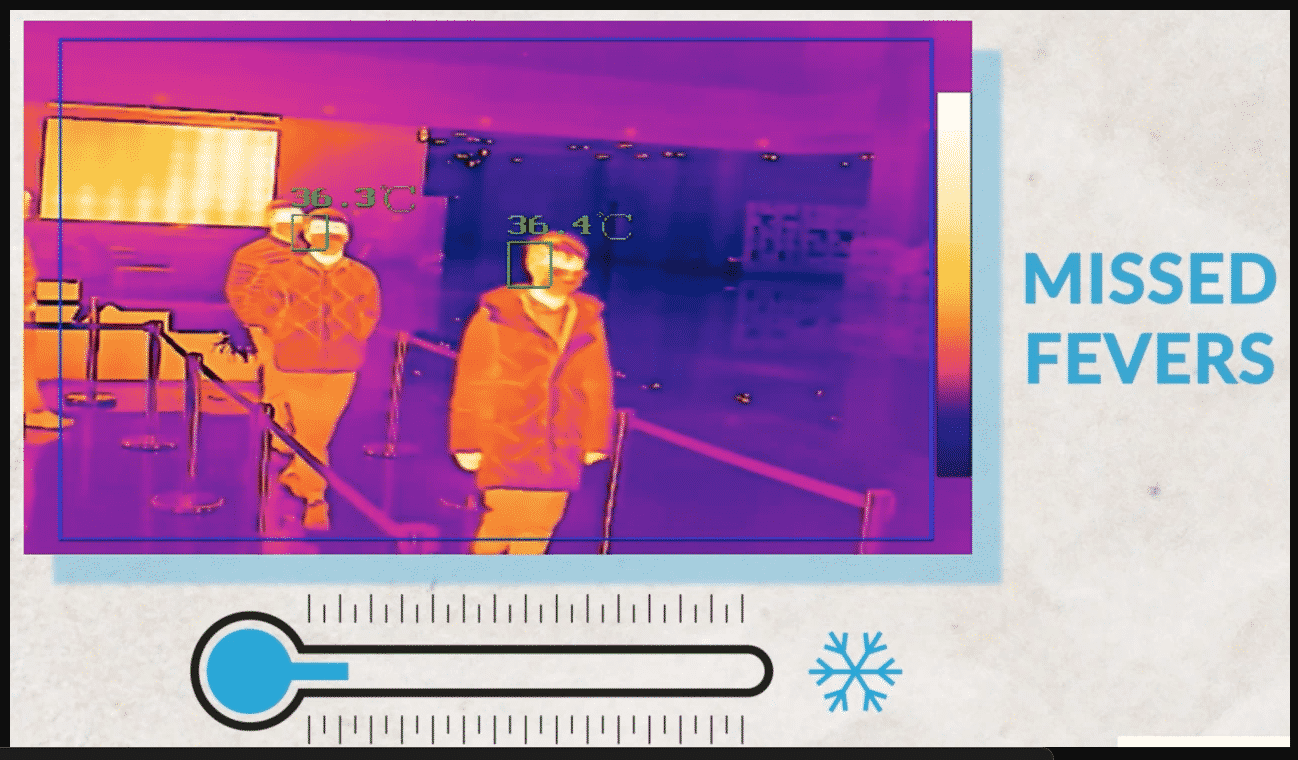
This Hikvision blog post declares they “Provide Safe, Accurate” screening and that it is ‘smart’ because it ‘only screens forehead skin surface’.
SixFlags video on new safety protocols including temperature screening.
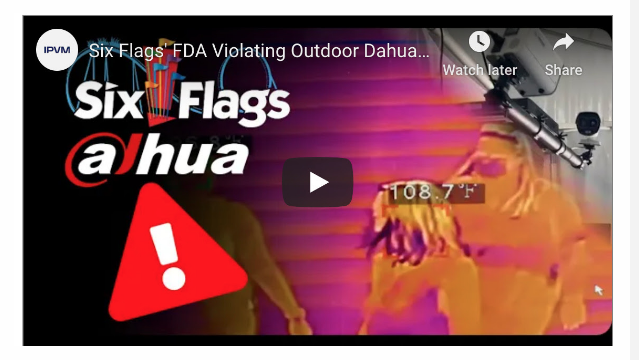
New article from IPVM detailing violations of outdoor temperature screening.
Excerpt:
As Six Flags scrambled to reopen parks amid plummeting revenues caused by the pandemic, it deployed Dahua fever cameras outdoors that violate FDA guidelines, creating a false sense of security and increasing risk to guests.
Despite that, Six Flags marketed Dahua devices as “new cutting edge thermal imaging” while showing false readings of up to 108° in its own marketing.
In this post, IPVM examines this issue in-depth.
Background
Due to COVID, Six Flags’ revenue dropped 96% in Q2 2020 and its stock price has fallen by about 50%. Currently, only a fraction of Six Flags parks worldwide are open.
To reassure visitors and investors, in May, Six Flags began promoting new safety measures such as mandatory mask wearing and what they claimed to be “state of the art thermal imaging for temperature checks”.
108°F Temperature Readings In Marketing
However, Six Flag’s own marketing video showed the problems with its outdoor temperature screening. In the segment where it touts this ‘cutting-edge thermal imaging’, the subject in the center of the screen’s temperature is measured at 102, 105, 107, even 108.7°F, as the excerpt below shows:
Read full article — New article from IPVM
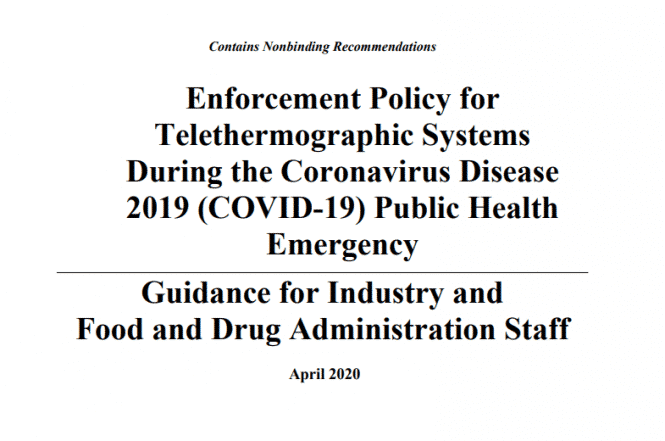
With regard to the FDA, they issued a statement in April 2020 that they “don’t intend to object” to those selling such cameras without FDA 510(k) clearance and the reason why:
Many of the approved manufacturers (14) are at a disadvantage in the near term.
For reference here is the actual FDA Enforcement Letter dated April 20. FDA COVID-19-Thermography-Devices-Guidance_0_0
Here is a point by point explanation of FDA statement.
FDA Reasoning: Fighting Shortage
The FDA said it is doing this as it wants to address the shortage of such devices
Policy Only Temporary
The FDA emphasized that this guidance is temporary:
Fever Cams Considered Medical Devices
Despite some companies falsely claiming their fever cameras are somehow not medical devices, in this guidance, the FDA clearly states that it does consider these products medical devices and under its regulatory purview
“Undue Risk”
However, the FDA emphasized, in the same guidance, that this only holds “where such devices do not create an undue risk”
FDA Recommendation: Only Use With Thermometer
Yes, the FDA said that 510(k) clearance is temporarily waived, it did state this was as long as the cameras are for “triage use”, i.e. the cameras are paired with a body thermometer to confirm whether the person actually has a fever
FDA Testing/Labeling Recommendations
The FDA recommended the fever cams are “tested and labeled consistent with the following ISO standard: IEC 80601-2-59:2017” or any “alternative performance specifications that provide similar results to IEC 80601-2-59:2017”.
The FDA recommended thermal cams are tested under following “performance specifications” including “measurement uncertainty, is less than or equal to ±0.5°C (±0.9°F) over the temperature range of at least 34-39°C (93.2-102.2°F)”
FDA Recommends Cameras Only Used One Person at A Time
Companies touting multiple goes against the FDA
Prominent Notice Labelling
A ‘prominent notice’ should be included, explaining the measurement should not be solely or primarily relied upon to diagnose or exclude a diagnosis of COVID-19, or any other disease
Mockup by IPVM
Performance and Labeling FDA believes such telethermographic devices will not create such an undue risk when the following circumstances related to the performance of the device and the transparency and clarity of information in the product labeling are present.
FDA recommends that the device:
1) Is tested and labeled consistent with the following standard: IEC 80601-2-59:2017: Medical electrical equipment – Part 2-59: Particular requirements for the basic safety and essential performance of screening thermographs for human febrile temperature screening; OR
2) Is tested using alternative performance specifications that provide similar results to IEC 80601-2-59:2017. This could include:
a) The laboratory temperature accuracy of a screening telethermographic system, including the measurement uncertainty, is less than or equal to ±0.5°C (±0.9°F) over the temperature range of at least 34-39°C (93.2-102.2°F);
b) The system includes an accurate blackbody temperature reference source; 10
c) Both stability and drift are less than 0.2°C (0.36°F) within a timeframe specified by the manufacturer; and
d) The device risk assessment addresses all potential safety issues, including:
i) Electrical safety;
ii) Electromagnetic compatibility;
iii) Mechanical safety;
iv) Excessive temperatures and other hazards;
v) Accuracy of controls, instruments, and information display;
vi) Considerations for software associated with Programmable Electrical Medical Systems including network connections;11 and
vii)Usability.
In addition, FDA recommends that the devices described above use labeling that helps users better understand the device, such as:
1) The labeling includes a prominent notice that the measurement should not be solely or primarily relied upon to diagnose or exclude a diagnosis of COVID-19, or any other disease;
2) The labeling includes a clear statement that:
a) Elevated body temperature in the context of use should be confirmed with secondary evaluation methods (e.g., an NCIT or clinical grade contact thermometer);12
10 This is usually a blackbody (idealized physical body that absorbs all incident electromagnetic radiation) with known temperature and emissivity that can be used for thermal drift compensation.
11 For more information on this recommendation, see Clause 201.14 of IEC 80601-2-59: 2017.
12 This labeling recommendation is consistent with IEC 80601-2-59: 2017.
Contains Nonbinding Recommendations 6
b) Public health officials, through their experience with the device in the particular environment of use, should determine the significance of any fever or elevated temperature based on the skin telethermographic temperature measurement;
c) The technology should be used to measure only one subject’s temperature at a time; and
d) Visible thermal patterns are only intended for locating the points from which to extract the thermal measurement.
3) The labeling includes a clear description of:
a) Device performance specifications and the methodology and frequency of any calibration needed to maintain the labeled specifications;12
b) How to use the thermal image to make a temperature measurement to within the stated device accuracy;
c) A description and purpose of the blackbody reference source (used for thermal drift compensation) and its importance in obtaining an accurate temperature assessment;
d) The reference body site used for temperature estimation, including any calibration or correction needed to estimate the temperature at that location, and the accuracy of the measurement at the reference site (e.g., oral, tympanic membrane);
e) How different environmental and system setup factors can affect the measurement, including the body site chosen for measurement, the condition of the screening site (e.g., screening background, ambient temperature and humidity, airflow);13
f) Different factors to consider in the design of the facility protocol (e.g., installation, viewing angle, blackbody temperature reference source); 14
g) The installation procedures and qualification testing that should be performed during installation or when imaging equipment is being relocated;15 and
h) The appropriate imaging distance based on the spatial resolution and performance of the camera. 16
4) The labeling references and is consistent with the guidelines in ISO/TR 13154: 2017: Medical electrical equipment — Deployment, implementation and operational guidelines for identifying febrile humans using a screening thermograph; and
5) The labeling highlights the differences in design, indications, or functions, as applicable, compared to the unmodified, FDA-cleared version of the product or includes a clear identification that the device is not FDA-cleared or approved.
Table of Contents
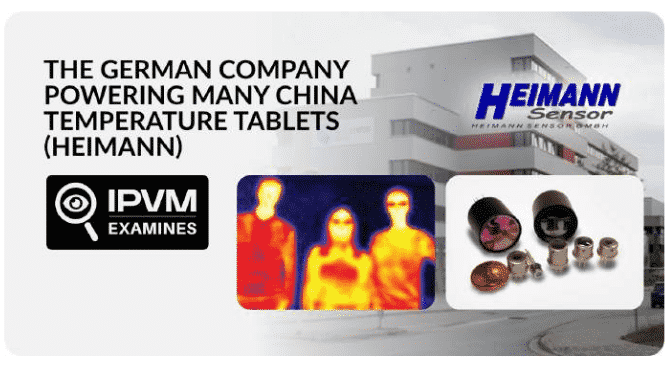
By: Charles Rollet, Published on Sep 16, 2020 | Email This
A Georgia school district touted buying Hikvision fever screening “about $2,000 cheaper per camera” with no blackbody for a total cost of a half a million dollars, despite the fact that these calibration devices are crucial for accuracy.

New report by IPVM issued on 9/22 testing the BEMs brand of temperature scanning tablets. Guangzhou Bems (brand Benshi) is the manufacturer behind temperature terminals relabeled by over a dozen Western companies. But how well do they really work?
The testing company bought and tested Bems temperature measurement tablet, examining the following:
Read full report New report by IPVM
Editors Note — With the non-negotiable requirements for web access for customers to order, the “website” has taken on even more importance and is now a critical component of company success. Getting sued for a lack of accessibility is not one of the outcomes you want. Complicate matters with which platform it uses, either desktop or mobile. Throw in language while at it. Taking steps to increase accessibility are relatively easy and low cost. KioWare integrates JAWS for example. We have very capable accessibility consultants such as Vispero and Tech For All that can help you perform full due diligence. Assistive devices by Storm Interface. Worth noting Biden plans on appointing a Director of Disability. President Biden was a cosponsor of the original ADA Act over 30 years ago.
The World Wide Web Consortium (W3C) has published the First Call Public Working Draft of its Web Content Accessibility Guidelines (WCAG) 3.0, which are developed through the W3C process in cooperation with individuals and organizations around the world. WCAG 3.0 provides new ways to evaluate web content accessibility for people with disabilities by addressing more types of disabilities, concentrating on both mobile and desktop applications, and developing new tests and scoring to determine accessibility.
Read the full post on new Accessibility Guidelines released with comment links on kma.global
LOS ANGELES, Calif., Jan. 15, 2020 (SEND2PRESS NEWSWIRE) — Olea Kiosks®, Inc., a visionary provider of self-service kiosk solutions, today announced expansion of its manufacturing and engineering capacity in Los Angeles, Calif. This expansion enables Olea to continue to grow its customer base, partnerships, and OEM relationships to provide faster time to market and greater operational agility.
Going from 48,000 square feet to more than 80,000 square feet, this investment allows Olea to grow its manufacturing volume in its current site and move test and assembly to the new facility next door. The company has also brought on additional engineering design resources and further invested in its data-driven approach to scale and automate internal processes.
Following the completion of site improvements in Q1, this expansion will also provide more floor space to stock additional items giving the company greater capacity to shorten turn-around times on its most popular kiosks.
“This is an exciting new chapter for Olea Kiosks and a considerable progression in our strategic journey,” said Frank Olea, Chief Executive Officer. “As a domestic supplier, we’ve prevailed in an extremely challenging competitive environment. With our universal models, custom designs, and OEM business, we want to further scale for production, field deployment, and support to provide increased value to our strategic partners and produce superior solutions for our customers while serving as a preferred supplier and employer for decades to come. This also gives us some additional space for more exciting changes later this year… more on that to come,” added Olea.
Many kiosk suppliers manufacture overseas, and while that can appear to deliver cost savings, it’s often in exchange for time-to-market, lack of control, inconvenience, and quality. With the addition of four new products over the last 18 months and just as many in 2021, Olea Kiosks® will further expand its rich and diverse self-service kiosk solution portfolio.
About Olea Kiosks®, Inc.
Olea Kiosks Inc., is a self-service kiosk solution provider for the attractions and entertainment, healthcare and hospitality industries. Its technologically advanced, in-house manufacturing, design, and innovation have made it an industry leader. Headquartered in Los Angeles, California, customers include The Habit Burger Grill, Kaiser Permanente, Empire State Building, Universal Studios, EVO Entertainment, Scientific Games, and Subway.
For more information, visit https://www.olea.com/.
*PHOTO link for media: https://www.Send2Press.com/300dpi/21-0115s2p-Olea-Building-Expansion-300dpi.jpg
*Caption: Olea Building Expansion.
News Source: Olea Kiosks